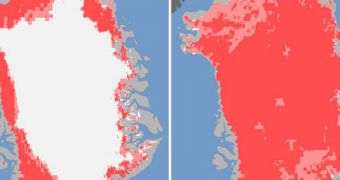Significant ice melts in the lower-altitude portions of Greenland are responsible for the overall darkening of the island, and for the decrease in the amount of sunlight it reflects back to space. This darkening, produced by heat, allows the remaining ices to be heated even more.
The conclusion belongs to a new study, which was informed by discoveries made two months ago. At the time, widespread snow and ice melting throughout the island – the planet's second-largest land-based ice reservoir after Antarctica – exceeded any previous record, Science Now reports.
One of the reasons why low-elevation snows are melting is that temperatures are so high they are not allowed enough time to get compressed into ice. The melting process is capable of supporting itself as a feedback loop, experts say.
Such extensive ice melts were recorded last month are known to occur in Greenland every 150 years. However, experts say that the next melting is unlikely to occur so long into the future. Most likely, the phenomenon will become increasingly common.

 14 DAY TRIAL //
14 DAY TRIAL //